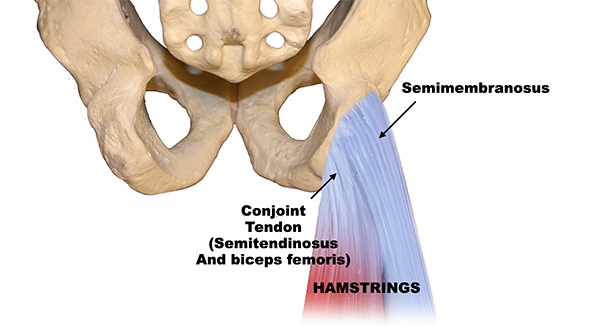Hamstring Injuries
What are the hamstring tendons?
The hamstring muscles are large muscles that attach to the pelvis, run down the back of the thigh, cross the knee, and attach to the upper end of the lower leg bones. The hamstring muscles are attached by hamstring tendons to the bones. The hamstring muscle group consists of three muscles: semitendinosus, semimembranosus, and biceps femoris. The hamstrings allow us to extend the leg and bend the knee. The hamstrings are balanced by the quadriceps muscles on the front of the thighs. The power and stability of the knees is controlled by the combined efforts of the hamstrings and quadriceps muscle groups.

Hamstring injuries refer to damage or strain to the hamstring muscle or tendon. A hamstring injury can commonly be classified as one of the following:
Hamstring Strain
This is the most common type of hamstring injury. A hamstring strain often occurs as a result of overstretching the muscle fibers and/or hamstring tendon. A hamstring strain involves stretching of the hamstring muscle or tendon without tearing,
Hamstring Tear
This occurs when a portion of the hamstring muscle fibers or tendon tears/ruptures. If only a portion of the hamstring muscle fibers or tendon tears, this is considered a partial hamstring tear. If a complete rupture occurs, then the full thickness of the muscle fiber or tendon has torn.
Hamstring Avulsion
This is the most severe type of hamstring injury, where the hamstring tendon fully separates from the pelvis bone where the hamstring inserts (ischial tuberosity).
Avulsion Injury
This occurs on rare occasions when the hamstring tendon pulls off a piece of bone with it when the tendon tears. Avulsion injuries occur from a burst of speed seen in ice skating, weightlifting, and skiing.
- Muscle Imbalance: One of the leading causes of hamstring injuries is muscle imbalance. When the quadriceps are significantly stronger than the hamstrings it can lead to an increased risk of hamstring injury.
- Inadequate Warm-Up: Failing to properly warm up before engaging in physical activities can make the hamstrings more susceptible to injury. A warm-up helps increase blood flow, muscle temperature, and flexibility.
- Sudden or Explosive Movements: Activities and sports that involve sudden and explosive movements, such as sprinting, running, lunging, jumping, kicking, or rapid changes in direction, put the hamstrings under considerable stress and can lead to injury.
- Fatigue: When the muscles are fatigued, they are more prone to injury. Overexertion and muscle fatigue can increase the risk of hamstring injuries. Excessive training, or overtraining, without adequate rest can lead to overuse injuries, including hamstring injuries.
- Lack of Flexibility: Inflexible hamstrings are more vulnerable to strains. Insufficient stretching can result in reduced flexibility and make the muscles more prone to overstretching.
- Previous Injuries: If you’ve had a previous hamstring injury, you may be more susceptible to re-injury due to residual weakness or scar tissue. Failing to rehabilitate and strengthen the hamstring muscles properly after an initial injury can leave them weakened and at risk for further damage.
- Poor Running or Biomechanics: Running with improper form or biomechanics can overload the hamstrings, increasing the risk of injury.
- Age: As people age, their muscles may lose some flexibility and elasticity, making the hamstrings more susceptible to injury.
- Environmental Factors: Running on uneven surfaces or in extreme weather conditions can increase the risk of hamstring injuries.
The symptoms of a hamstring injury can vary in severity depending on the extent of the injury. Common symptoms of a hamstring injury include:
- A sharp pain in the middle or upper back of the thigh near the buttocks. The intensity of the pain can range from mild to severe, depending on the severity of the hamstring injury.
- Difficulty putting weight on the injured leg, causing limping.
- Swelling
- Bruising and discoloration
- Hamstring weakness
- Muscle spasms or cramps
- Difficulty fully extending or straightening the leg.
- Audible “pop” or snapping sound at the time of injury, especially in severe hamstring injuries.
During your consultation with Dr. Jorge Chahla, a Chicago sports medicine surgeon and hamstring specialist, your medical history, hamstring tendon symptoms, and past injuries will be reviewed.
Physical Exam
Dr. Chahla will conduct a physical examination checking for bruising, tenderness, weakness, and swelling. If the tendon has pulled away from the bone, the muscle will appear balled up at the back of the thigh.
Imaging
X-rays will reveal an avulsion if the hamstring tendon has pulled a piece of bone away with it during the hamstring injury. An MRI of the hip will provide detailed images of the hamstring tendon, including the location of the injury, the extent of the injury, and the degree of hamstring tendon retraction.
Hamstring injuries occur when the muscles or tendons in the back of the thigh are strained or torn, often due to sudden acceleration, overstretching, or repetitive stress. Symptoms include pain, swelling, bruising, and difficulty walking or bending the knee. Dr. Jorge Chahla, a leading orthopedic hip and sports medicine specialist, provides expert care for hamstring injuries, offering both non-surgical and surgical treatment options. If you have sustained a hamstring injury, contact Dr. Chahla’s office in Chicago, Naperville, or Oak Brook for an evaluation and treatment plan.
At a Glance
Dr. Jorge Chahla
- Triple fellowship-trained sports medicine surgeon
- Performs over 800 surgeries per year
- Associate professor of orthopedic surgery at Rush University
- Learn more

